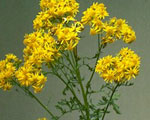Dyers woad
tansy ragwort
Sencio jacobea L. (Asteraceae)
Weed ID Links
Photo's: Http://dnr.metrokc.gov/wlr/LANDS/Weeds/ragwort.htm
 Line Drawing
Line Drawing
Photo used with permission from: Pierce
County (Washington)
Noxious Weed Control Board.
Description: Tansy ragwart, Sencio jacobea,
the plants stem stands straight up and branches out at the
top. This plant is a biennial plant, it sprouts in late fall
or early winter. The plant will live through the next year
and after blooming and producing seeds it will die the following
year. These plants get to about 6-feet high, with yellow
colored flower petals numbering about 13 petals each.
Roots: The plant’s
roots
start to spread from the crown of the plant, they are light in
color and have a fibrous system structure.
Leaves: The
leaves of this plant usually are dark green on top, and a whitish
green on the bottom. They appear ragged and ruffled with a
deeply cut blunt toothed lobe.
Stem: The
stems grow one to six feet tall.
Flower:
The flowers of this weed are yellow in color, they have umbrella
shaped clusters that occur at the top of a long stock. They
have 13 petals in a group and they look like small yellow daises.
Toxicity:
The whole tansy ragwort plant is poisonous. The stems
contain about 25 to 50 percent of the alkaloid found in the
leaves, but the flowers contain about twice as much as the
leaves. Tansy ragwort has six different pyrrolizidine
alkaloids, which combine and add up in the liver of herbivores
over time. When these materials are transferred into
pyrroles, they cause liver damage. Intoxication often
happens when small plants combined with desirable forage plants
are ingested unknowingly by cattle and horses while grazing.
After consuming 3 to 7 percent of their body weight of this
noxious weed, animals may die. If they do not die, the milk
produced by them could become toxic.
Environments
Favorable to Infestation: It can survive in most soil with
moist conditions, and also if the temp. is hot, dry summers of the
eastern part of the Pacific Northwest,
and successfully survives in areas where temperatures can reach
-20°F or lower if it has good snow cover.
Impacts: This
plant when eaten by live stock can cause liver cancer and eventual
death. Once eaten by the organism the harmful materials and toxic
milk stays in the organisms system and build up over time.
The economic loss due to this plant is caused by the loss of money
trying to control it and the loss of live stock due to ingesting
the plant.
Native Range/Entry
to North America: Tansy ragwort originated in Europe. Tansy
ragwort is a major problem in Oregon,
Washington, and northern California.
But,
it was originally spotted by seaports in the early 1900's.
The weed seeds were carried by straw and hay brought by hunters
from infested areas west of the Cascades.
Methods of
Control/How to Prevent Spread: Biological control
is the use of natural enemies that feed only on tansy
ragwort. This method is effective in reducing plant
population and is recommended for places where other methods
controls are not economical. This process requires several
years to establish an insect population big enough to reduce a
weed population. The objective is not to destroy tansy
ragwort but to reduce it to a level that is economically
controllable. Three insects have been imported to eat tansy
ragwort, these are the cinnabar moth, the ragwort seed fly, and
the Tansy ragwort flea beetle.
Links:
Http://dnr.metrokc.gov/wlr/LANDS/Weeds/ragwort.htm
http://piercecountyweedboard.wsu.edu/Tansy.html
http://www.wa.gov/agr/weedboard/weed_info/tragwort.html
http://web.css.orst.edu/Topics/Pests/Weeds/Tansy/index.html
http://dnr.metrokc.gov/Weeds/ragwort.htm
webmaster@forages.css.orst.ede
http://www.agf.gov.bc.ca/cropprot/tansy.htm
http://www.oneplan.org/Crop/noxWeeds/nxWeed32.htm
http://www.efn.org/~ipmpa/Noxtansy.html
http://res2.agr.ca/lethbridge/weedbio/plant/btanrag_e.htm
Bibliography
1) Natural Resources and Parks, Land and Water Resources Division:
Tansy Ragwort Noxious Weed Identification, [Online] Available:
Http://dnr.metrokc.gov/wlr/LANDS/Weeds/ragwort.htm, for questions
please contact Jane Wentworth.
2) The Pierce County Noxious Weed
Control Board, Tansy ragwort, [Online] Available: http://piercecountyweedboard.wsu.edu/Tansy.html,
for questions call (253) 798-7263 weekdays between 7:30 am and 4
pm, 1/16/02.
3) The Washington State Noxious
Weed Control Board, Tansy ragwort, [Online] Available: http://www.wa.gov/agr/weedboard/weed_info/tragwort.html,
last updated on 7/11/01.
4) Made by L.C. Burrill, R.H.
Callihan, R. Parker, E. Coombs, and H. Radtke, Forage Information Center, Tansy ragwort,
[Online] Available: http://web.css.orst.edu/Topics/Pests/Weeds/Tansy/index.html,
for any questions please send e-mail to webmaster@forages.css.orst.ede,
last updated on July 30, 1997.
5) King County.
Tansy Ragwort. http://dnr.metrokc.gov/Weeds/ragwort.htm
November 23,
2005.
mtwow.org HOME
Back to Weed ID
By: Kip Becraft
3/2002. Updated by: Ben Wideman
2/21/06.
 Line Drawing
Line Drawing